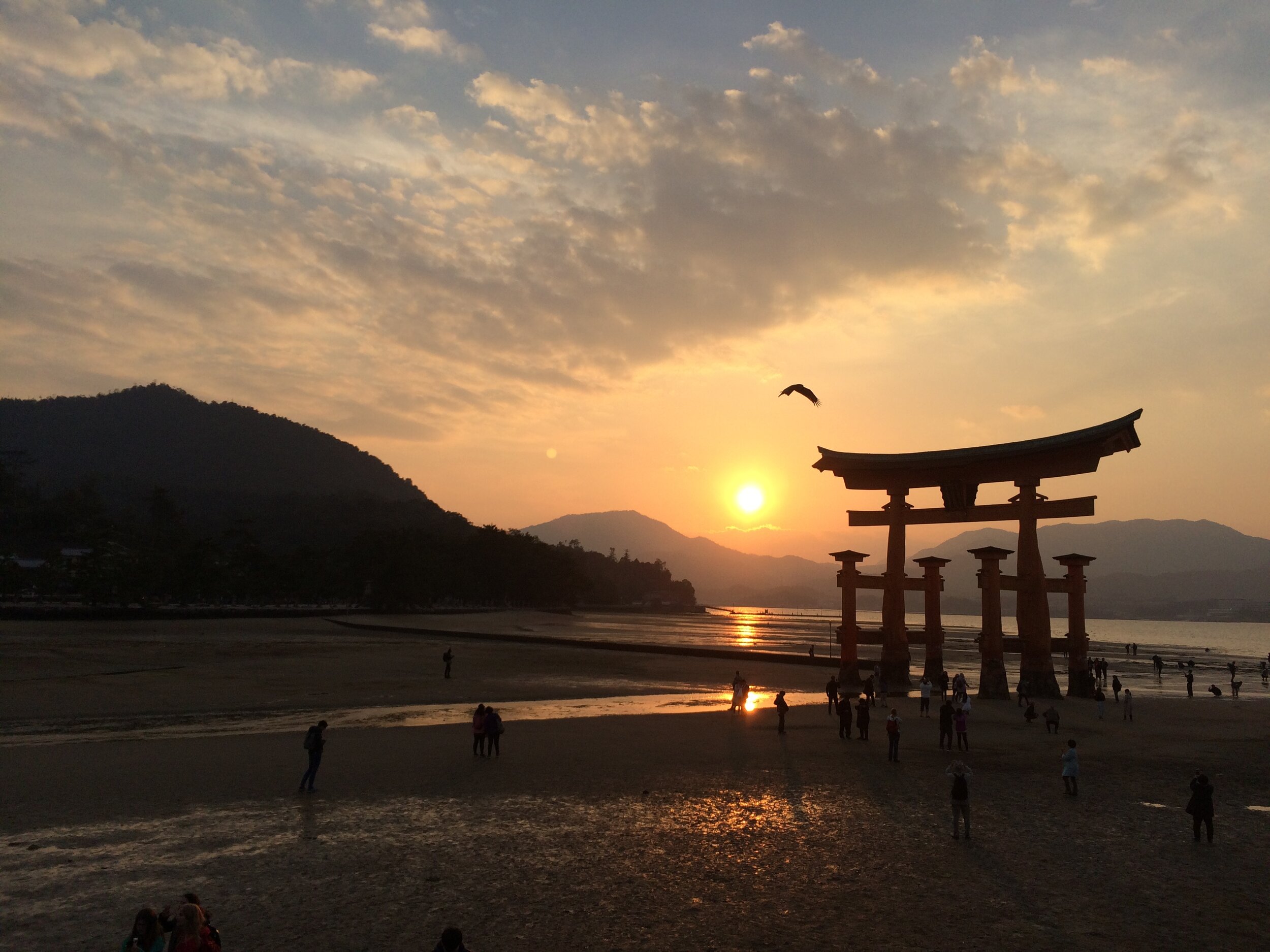夢を叶える-宮島 Miyajima
Photo Credit: Hannah-san
今回(こんかい)は、ハナさんとマットさんが訪(おとず)れた宮島(宮島)について書(か)きます。ハナさんは今回の日本(にほん)での旅行(りょこう)で宮島が一番(いちばん)気(き)に入(い)ったそうです。私(わたし)も宮島(みやじま)が大好(だいす)きですから、宮島の写真(しゃしん)をこのブログや私のホームページにも使(つか)っています。
This time, I would like to write about Miyajima, one of the places Hannah-san and Matt-san visited in Japan. Hannah-san said that Miyajima was her favorite place of all. I love Miyajima as well and am using my photo of Miyajima in this blog as well as my website.
Photo Credit: Yoko Irisawa
島(しま)とは英語(えいご)でアイランドと言(い)う意味(いみ)ですが、「宮島(みやじま)」と「厳島(いつくしま)」は同(おな)じ場所(ばしょ)のことです。江戸時代(えどじだい)に、お宮(みや)は神社(じんじゃ)のことで、そして厳島神社がある島であることから「宮島」と呼(よ)ばれるようになったそうです。
Shima means island in English, and “Miyajima” and “Itsukushima” are the same place. (When the word, island, is used alone, it is pronounced as “shima”, and when it is compounded with a name of the island, it is pronounced as -jima. ) They say, as both Miya and Jinja mean a shrine, during the Edo-period, people started to call the island Miyajima which means a shrine island.
Photo Credit: Hannah-san
調(しら)べたとこころ、日本には25の世界遺産(せかいいさん)があるそうですが、宮島もその一つです。海上(かいじょう)にある神社(じんじゃ)は、満潮時(まんちょうじ)には海(うみ)の中(なか)に朱色(しゅいろ)の美(うつく)しい鳥居(とりい)が浮(う)いているように見(み)え、干潮時(かんちょうじ)には浜(はま)に立(た)つ鳥居(とりい)の下(した)を通(とお)ることもできます。
According to my research, Japan has 25 world heritage sites and Miyajima is one of them. The shrine on the ocean creates the illusion of the shrine gate in vermillion; it is floating on the water when it’s high tide, and people can walk through the big shrine gate on the beach when it’s low tide.
一番(いちばん)良(よ/い)い宮島の眺(なが)めは弥山(みせん)という山の山頂(ちょうじょう)からだそうですが、私は登(のぼ)ったことがありません。そこからは、瀬戸内海(せとないかい)に浮(う)かぶ多(おお)くの島(しま)や四国(しこく)や九州(きゅうしゅう)までも見(み)えるそうです。
They say that the best view of Miyajima can be appreciated from the top of Mt. Misen. Unfortunately, I have never climbed Mt. Misen, but they say that we can view many islands in Seto Inland Sea.
Photo Credit: Yoko Irisawa
宮島に限(かぎ)らず、日本では神道(しんとう)と仏教(ぶっきょう)は共存(きょうぞん)してきました。この弥山という山は真言宗(しんごんしゅう)の祖(そ)、弘法大師(こうぼうだいし)が唐(とう)から日本へ帰国(きこく)し、宮島で修行(しゅぎょう)をした山(やま)だそうです。ご興味(きょうみ)がおありでしたら、是非(ぜひ)宮島弥山大本山大聖院(みやじまみせんだいほんざんだいせいいん)のホームページをご覧(らん)ください。https://daisho-in.com/about_daishoin.html
Not only in Miyajima, but elsewhere in Japan, Shinto and Buddhism coexisted. This Mt. Misen, is where the founder of Shingon Sect, Kukai. After Kukai returned to Japan from the Tang Dynasty, he traveled to Miyajima and trained at Mt. Misen. If you are interested, please read https://daisho-in.com/about_daishoin.html#
ハナさんとマットさんは、神社(じんじゃ)で参拝(さんぱい)したり、鹿(しか)の写真(しゃしん)をとったり、宮島歴史民俗資料館(みやじまれきしみんぞくしりょうかん)へ行(い)ったり、おむすびのお昼(ひる)ご飯(はん)を食(た)べたり、大聖院を見学(けんがく)したりしたりした後(あと)、天津閣(てんしんかく)というカフェで休憩(きゅうけい)したそうです。そして、夜(よる)は宮島にあるかまだという民宿(みんしゅく)に泊(と)まったそうです。そこでは、1日(いちにち)にひとグループのゲストだけが泊まることができるそうです。朝(あさ)ごはんは、民宿のオーナーさんたちと日本語と英語(えいご)で「赤毛(あかげ)のアン」の話(はなし)をしたりして、とても楽(たの)しかったそうです。私(わたし)もそこに泊まってみたいです。
Photo Credit: Hannah-san
Hannah-san and Matt-san visited the shrine, took some photos of deer, visited the Miyajima History and Folklore Museum, enjoyed some o-musubi (riceballs), had a tour at the Daisheein, then had a tea break at Tenshinkaku Cafe. At the end of the day, they stayed at the inn, Kamada, which accepts only one group of guests per day. They had breakfast with the owner of the inn and enjoyed talking with them in Japanese and English over Anne of Green Gables. I would love to stay in the Inn in the future.
Photo Credit: Hannah-san





